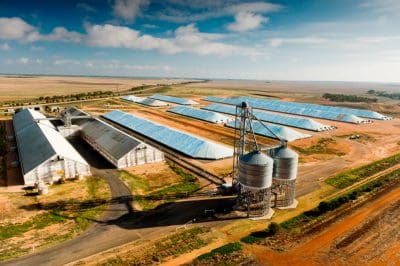A South Australian logistics specialist has submitted a scathing criticism of Viterra’s operations to the South Australian government review into bulk grain supply-chain costs.

Viterra operates South Australia’s bulk-handling system, which includes this facility at Loxton.
The specialist, John Hill, was engaged in negotiating grain storage and logistics in Australia over several decades, and said SA grain handling charges had once been the lowest in the country.
He said the grain handling component of Viterra’s charges was almost double that of the Western Australian bulk-handling system, operated by CBH Group, and significantly higher than major eastern states bulk handler, GrainCorp Ltd.
In his submission, Mr Hill said it was difficult to see why this had changed so significantly.
A submission from grower organisation, Grain Producers SA (GPSA), also drew a comparison between Western Australian and South Australian charges.
It cited as an example that the 2016/17 season costs at Port Adelaide terminal were around $17/t above charges at CBH Group’s Kwinana terminal.
“The way grain-handling prices are set in South Australia lacks transparency,” GPSA chief executive officer Darren Arney said.
“Charges through Port Adelaide are now around $50/t,” he said.
Mr Arney was concerned that the high system cost structure lowered the baseline farm price for all.
“Higher handling prices mean lower farm returns and profitability for all South Australian producers whether they are selling into local markets or into export.”
Other voices
Viterra, the South Australian Freight Council (SAFC), Melbourne-based economics consultants, Philip Norman and Associates, and Primary Industries and Regions SA (PIRSA) also made submissions.
In its submission, Viterra reported consistent high standards of quality, safety, reliability and sustainability which demonstrated the supply chain was working well.
It noted the company’s strong customer focus in a competitive environment and its underwriting of risk for the industry.
Viterra also used its submission to call for reduced regulation, citing the strictures of operating in a “disproportionately highly regulatory framework compared to other states”.
The SAFC submission expressed concern over the decline in the importance of rail, placing increased load and cost on publicly owned roads.
SAFC suggested the inquiry may find Eyre Peninsula a likely place to increase rail’s share of grain transport.
In its submission, GPSA fired a broadside at the system of rail freight deductions, in particular the incongruence between actual charges — negotiations between rail-service provider and client not made public — and notional freight charges via the Grain Trade Australia (GTA) location differentials.
It warned of poor outcomes from a lack of investment in rail; that the Rail Access Regime has stimulated no additional competition since the Railways (Operations and Access) Act 1997 was gazetted.
Melbourne-based consulting economists, Philip Norman and Associates, suggested opportunities for benchmarking ports, and said the Commission needed to review aspects of segregation, capacity utilisation, interport competition and on-farm storage.
It said there had been good understanding of the historic need for grain segregation and quality assurance to earn Australian wheat higher margins internationally.
It made reference to maximising the competitive value of South Australian grain against competition such as the Black Sea origins.
This is in line with Australian Export Grain Innovations Centre (AEGIC) conclusions on export competitiveness of Australian grains.
No submission was received from an exporter. Several exporters which use Viterra’s South Australian facilities were contacted by Grain Central, but all declined to comment.
The way forward
The purpose of the inquiry, as described by the Essential Services Commission of South Australia (ESCOSA) is to determine the “reasonableness” of the costs underpinning the South Australian bulk grain supply chain.
Its terms of reference require ESCOSA to look into the South Australian bulk grain export supply chain costs over the past 10 years in Part 1, and the submissions have provided input for assessment by the Commission.
Should it find areas where bulk grain supply chain costs are identified as inefficient, the Commission will undertake Part 2 of the inquiry to explore options.
Boom and bust
In its submission, PIRSA identified examples of a high-production year such as 2016, and 2006 as a low production year, in which the state produced a crop total estimated at 11.1 million tonnes (Mt) and 2.9Mt respectively.
Viterra reported the 10-year average annual export task from South Australia as 5.2Mt, varied significantly, with record shipping of just under 8Mt in 2010/11.
Viterra responded to the crop record 2016 handling task by constructing 900,000t additional storage, roughly equivalent to the state’s on-farm storage estimated capacity around 1Mt as reported by PIRSA.
Other submissions reported the high fixed-cost nature of bulk handling, to be borne by fewer tonnes in a tight year and more tonnes in a record year such as the 2016 harvest.
The SA system
Viterra operates all of South Australia’s export grain terminals, which are located at Ardrossan, Port Adelaide, Port Giles, Port Lincoln, Thevenard and Wallaroo, and an extensive up-country bulk-handling network.
It received grain at 83 sites in the recent harvest.
Around 20 non-Viterra commercial sites operate in South Australia for domestic milling supply and (principally container) export accumulation.



HAVE YOUR SAY